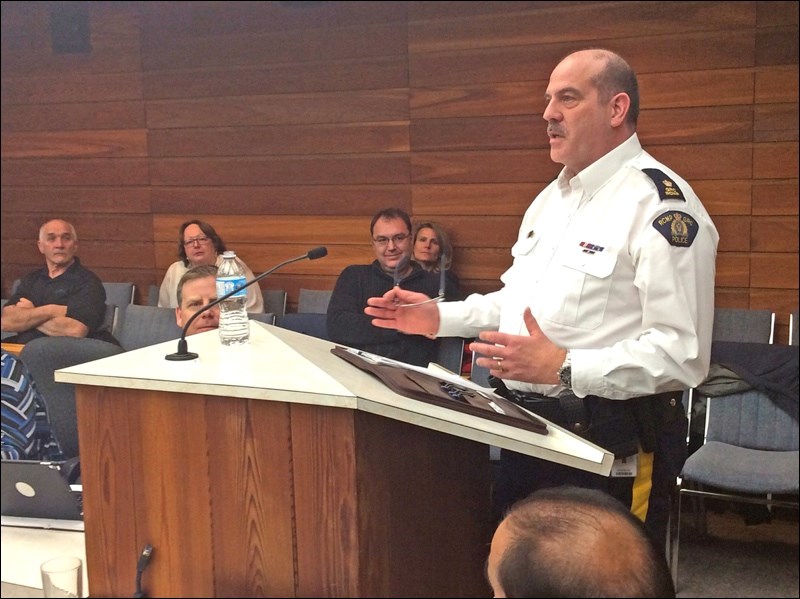The final crime statistical numbers are in for North Battleford for 2017, but while weapons offences are a concern, there wasn’t a dramatic change compared to a year ago.
According to the Battlefords City Detachment statistical report presented to council Monday for 2017, there were 13,585 calls for service in 2017, four more than the 13,581 recorded in 2016.
Much of the reason why calls for service were almost the same as last year had to do with an increase in calls for assistance of other police agencies, property checks and assisting the general public. There were 1,748 in this category, up from 1,326 in 2016.
While those numbers were going up, the good news was that most crime categories saw declines in 2017, albeit modest ones for the most part.
Persons offences were down from 1,270 to 1,266; business break and enters were down from 67 to 41; residential break and enters were down from 194 to 189; property offences dropped from 3,020 to 3,002; criminal code offences were down from 2,465 to 2,432; liquor acts were down from 770 to 424; provincial traffic offences down from 1,122 to 1,059; and impaired operation of a motor vehicle was down from 309 to 221.
There were increases for the year in drug offences from177 to 197; municipal bylaw offences went up from 123 to 169 and motor vehicle collisions went up from 252 to 278.
While year-end numbers saw decreases, the October-to-December fourth quarter – a period dominated by crime headlines – saw a spike in calls for service from 3,012 to 4,798.
The period saw increases compared to a year earlier in property offences from 597 to 686, in criminal code offences from 527 to 542, in drug offences from 43 to 47, and in provincial traffic offences from 270 to 338. Motor vehicle collisions were also up from 43 to 47, and municipal bylaw offences climbed from 17 to 38.
But declines were noted in person offences from 296 to 264, break and enters to business from 12 to 4, residential break and enters from 66 to 29, liquor acts from 163 to 59, and impaired operation of a motor vehicle from 76 to 40.
Most troubling in the statistics was the increase noted in firearms and weapons offences for both the fourth quarter and for the entire year.
In the quarter, persons offences involving firearms were up from 10 to 14, and criminal code weapons offences climbed from 12 to 17. For the year, persons offences involving firearms were up from 43 to 46, and criminal code weapons offences were up from 54 to 77.
RCMP Insp. John Sutherland had highlighted the firearms offences, saying “certainly we’ve had a lot of offences in the news lately, firearms stuff.”
But when looking at the overall numbers it wasn’t a big change, he noted.
“While the numbers aren’t, like they say, lower, at least we haven’t seen a sharp increase although we’ve seen more news stories about it.”
He attributed the rise in news stories to the communications efforts of the detachment lately in getting more information out to the public.
Insp. Sutherland did say that “weapons of opportunity” – bear mace, knives and the like – were a concern, and something that would be addressed as part of a targeted enforcement initiative by the RCMP in the future.
The plan is for high profile and high-visibility “crime suppression patrols” to be created. The detachment is also developing a long-term strategy alongside the city to address the issue.
The initiative, according to Sutherland, will target those individuals causing the high calls for service and “make them aware we’re not open to that type of business,” he said.
Some extra funding will be needed for that, and a draft operational plan is being drawn up. More details are to come on that initiative in the near future.
Another important initiative Sutherland spoke about is a mental health initiative being started by the province that will see police team up with a mental health worker to address calls for service that have mental health components to them.
The goal is to deliver services before they reach a crisis point, with proactive home visits, attendance of mental health workers at their cells at the detachment, and having mental health workers assist members in dealing with patients during times of crisis.
He also noted planning is under way for the Saskatchewan Winter Games to ensure an integrated response.
Sutherland’s presentation had followed the monthly report of Herb Sutton as well as the presentation of Gary Nolin, from the province, on “collective impact.” In response to those presentations the RCMP inspector pointed to progress on community safety.
Sutherland noted that when he first joined the city detachment as inspector four years ago – when he “had hair,” he joked – he recalled that at the first council meeting the talk had been about a shelter being open for only a couple of months. That was before the opening of the 24-hour Lighthouse facility.
“Everybody should be pretty proud of what they’re delivering here. It’s pretty significant changes from my perspective,” said Sutherland.




